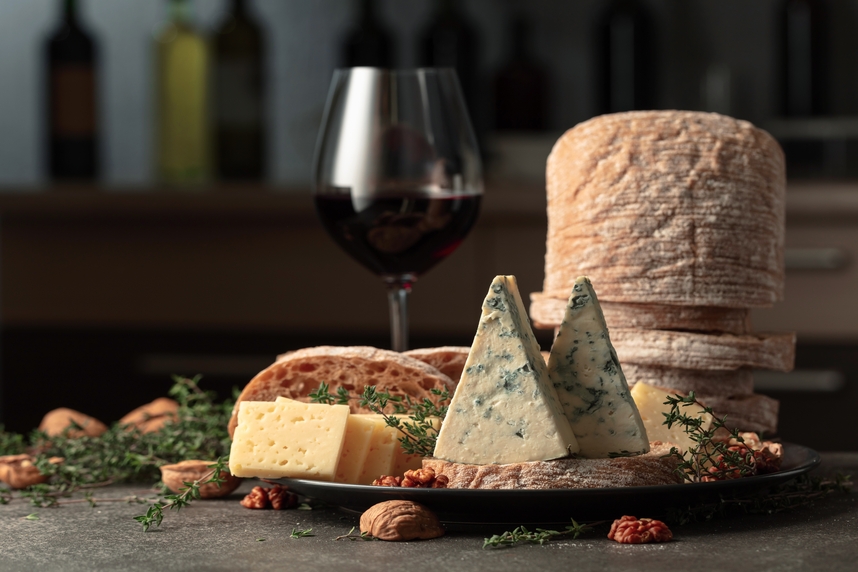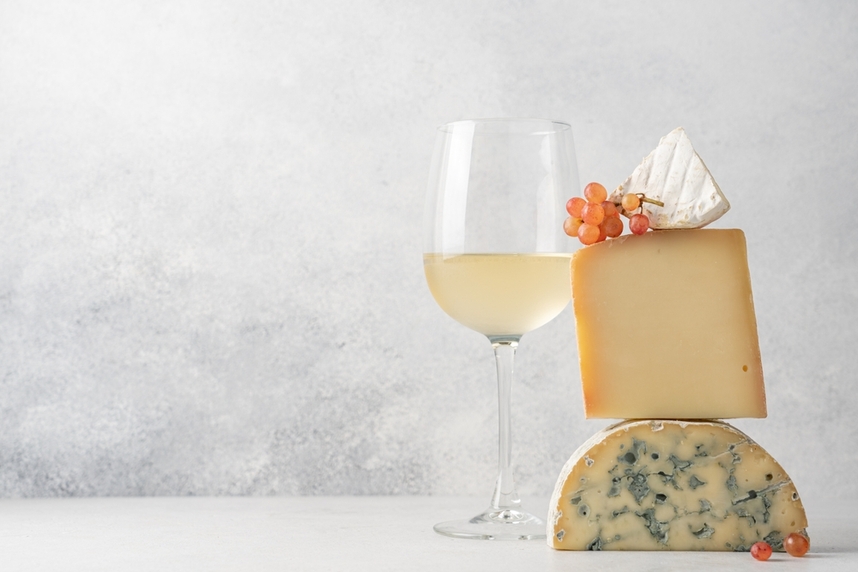Whether it's for a flavoursome starter, for an aperitif with friends or for a tasting at the end of a meal, a cheese board is an indulgence that's hard to resist. And if there's also a glass of wine involved, the experience becomes even more interesting, thanks to the excellent balance between the alcoholic, fruity and acidic components of certain wines and the rich and savoury sensations of many cheeses.
To choose the right label based on the type of ingredient, here's a guide to wine and cheese pairing!
Wine and cheese pairing: general rules to follow
Saying cheese means saying everything and nothing, since within this macro-category there exists an almost infinite range of varieties, all with their own nuances of taste.
Uncorking just any wine could lead to unpleasant results, but simply following the most famous pairing styles will achieve a tasty and balanced result:
- Pairing by harmony: this consists of finding a concordance between the cheese's consistency or degree of ageing and the wine's structure. A hard, aged cheese, characterised by a tendency towards more intense flavour, finds a good pairing with a full-bodied and decisive A wine with a high alcohol content, moreover, is able to break down fats into simpler molecules, making the tasting of this type of cheese more balanced and pleasant.
- Pairing by contrast: this criterion involves the combination of different or even opposite flavours, so as to harmonise extremes. It's generally applied with fatty cheeses with a sweetish component, to be balanced with a wine or sparkling wine with acidic and savoury traits.
- Pairing by wine type: whites generally present a good level of acidity, which sits comfortably with fresh and low-fat cheeses (if the wine is young), or fatty or sweet ones (if the wine is a bit more structured). Reds can be risky due to their tannins, which are unpleasant when paired with casein. Generally speaking, young and slightly acidic reds pair well with fatty cheeses, whilst structured ones go perfectly with aged cheeses. Rosés, light and lively, are much appreciated with pasta filata cheeses, whilst sparkling wines can lighten the decisive taste of aged products thanks to their effervescence.
Wine and cheese tasting tips

The world of dairy products is much more complex than one might imagine, and finding the best wine for cheeses can prove to be quite a task. However, Svinando is here to simplify everything with some unmissable suggestions!
Aged hard and semi-hard cheeses
Hard and semi-hard cheeses are those that retain a low percentage of water within them, a characteristic that gives a more intense flavour compared to soft or fresh cheeses. Aromas and flavours are generally also amplified by the ageing period, which remains below six months for semi-aged cheeses and exceeds it instead in the case of aged ones.
Semi-aged cheeses such as Single Gloucester, Cornish Yarg, Coquetdale and Cheshire, require alongside them a wine that is at the same time fresh and of good structure, like a Chianti. Besides a beautiful bright ruby colour, it displays lively notes of red fruits and violet that create an excellent balance with cheeses of this type. What creates a perfectly balanced tasting, however, is above all the taste of this Chianti Classico DOCG 2023, characterised by marked freshness and delicate tannins.
If instead the cheese tasting concentrates on products subjected to greater ageing - such as Red Leicester, aged Cheddar, Lincolnshire Poacher or an Italian Parmigiano - one can uncork a more decisive and full-bodied wine, but with few tannins, or a bubble of good structure, capable of supporting the intense taste of these cheeses, lightening the palate with good vivacity.
An excellent wine for cheese, in this case, is the Alta Langa "Oltrequota Cinquecento" Brut DOCG, characterised by a refined perlage and a bouquet of bread crust, dried fruit and yeast due to 30 months of bottle ageing. On the palate it displays the gustatory richness necessary to hold its own against an aged cheese with a bold taste!
Which wine to pair with fresh cheeses and soft-paste cheeses?
Although many people confuse fresh cheeses and soft-paste cheeses with each other, they are actually two distinct categories.
Fresh cheeses - such as Crowdie, Colwick, Perroche and Childwickbury - don't require ageing or at most mature for a period less than a month before being consumed. This influences their characteristics, among which the soft consistency stands out, sometimes creamy, and a milky and slightly acidic flavour. These cheeses require a young, light wine with a moderate alcohol content, like a Bardolino DOC Chiaretto Tenuta Cariola 2024. Its lightness doesn't put it too much in contrast with the delicacy of these cheeses, whilst the soft aromas of raspberries and wild flowers and the fresh and round sip, soften the gustatory experience.
Soft-paste cheeses, instead, are subjected to a brief maturation period and present a creamy consistency due to the high percentage of water contained in the paste. These products - some examples are British Brie, Caboc, Tunworth and Waterloo - present a sweet aftertaste and a discrete fat content, since they're generally produced with whole milk, sometimes with the addition of cream.
For the choice of wine in this case it's good to aim for a fresh product with an acidic aftertaste, like a Franciacorta sparkling wine, an Italian Metodo Classico of great prestige, well represented by a "Berlucchi 61" Franciacorta Extra Brut DOCG, characterised by a persistent and fragrant foam, by enchanting aromas of white fruit and citrus and an elegant, citrusy and pleasantly acidic taste.
The best wine for blue cheeses
Cheeses are defined as blue - or blue cheese - that are produced through the addition of mould spores to the milk, which proliferate during maturation in contact with air. This process, completely safe and controlled, gives rise to the typical blue, green or grey veins and confer a more decisive flavour, which can present sweet or acidic nuances depending on the style.
Stilton, Stichelton, Oxford Blue, Dovedale and many others belong to this category, varieties that can encounter some difficulty in pairing, precisely because of their pungent character. An excellent idea in this case is to pair sweet wine and blue cheeses - and thus give life to a pairing by contrast - calling into play for example aromatic wines based on Moscato, Passitos or Late Harvest wines.
An excellent example for this context is the Gewürztraminer Late Harvest Trentino DOC Superiore, often called upon when cakes, tarts or pastries arrive at the table, but also excellent with a blue cheese board. The scratchy tones of these products can in fact be smoothed by the enchanting aromas of dried apricots and tropical fruit of this Trentino white, as well as by the sip perfectly balanced between freshness, acidity and sweetness.
All ready for cheese tasting? Now that you know how to pair them with wine, find the right bottle in the Svinando catalogue!

